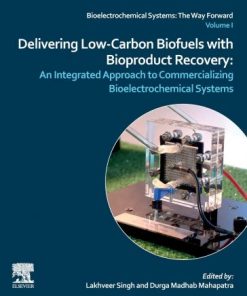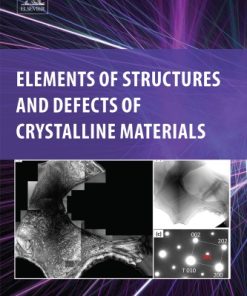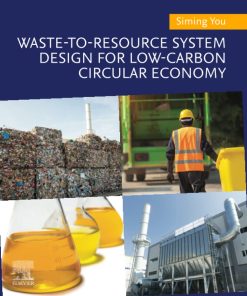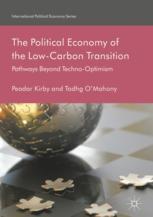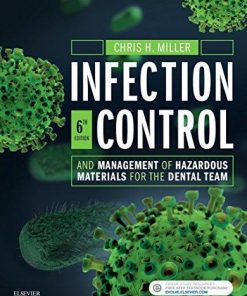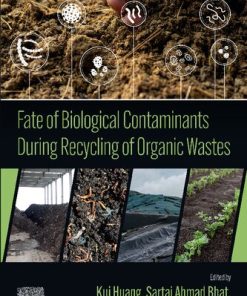Low Carbon Stabilization and Solidification of Hazardous Wastes 1st edition by Daniel Tsang, Lei Wang 0128242520 9780128242520
$50.00 Original price was: $50.00.$25.00Current price is: $25.00.
Low Carbon Stabilization and Solidification of Hazardous Wastes 1st edition by Daniel C.W. Tsang, Lei Wang – Ebook PDF Instant Download/DeliveryISBN: 0128242520, 9780128242520
Full download Low Carbon Stabilization and Solidification of Hazardous Wastes 1st edition after payment.
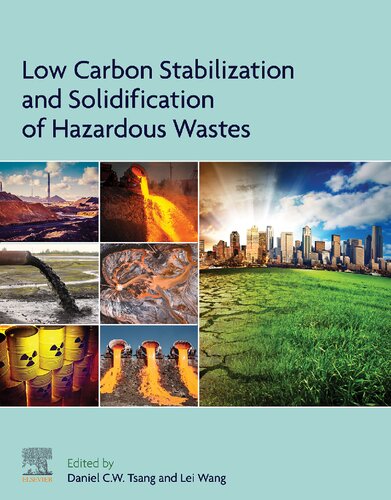
Product details:
ISBN-10 : 0128242520
ISBN-13 : 9780128242520
Author: Daniel C.W. Tsang, Lei Wang
Low Carbon Stabilization and Solidification of Hazardous Wastes details sustainable and low-carbon treatments for addressing environmental pollution problems, critically reviewing low-carbon stabilization/solidification technologies. This book presents the latest state-of-the-art knowledge of low-carbon stabilization/solidification technologies to provide cost-effective sustainable solutions for real-life environmental problems related to hazardous wastes including contaminated sediments. As stabilization/solidification is one of the most widely used waste remediation methods for its versatility, fast implementation and final treatment of hazardous waste treatment, it is imperative that those working in this field follow the most recent developments.
Low Carbon Stabilization and Solidification of Hazardous Wastes 1st Table of contents:
Chapter 1. Overview of hazardous waste treatment and stabilization/solidification technology
Abstract
1.1 Introduction
1.2 Sustainable waste management
1.3 Overview of current waste treatment technologies
1.4 Sustainable stabilization/solidification
1.5 Conclusion and prospects
References
Chapter 2. Green and low-carbon cement for stabilization/solidification
Abstract
2.1 Introduction
2.2 Ordinary Portland cement stabilization/solidification
2.3 Supplementary cementitious materials blended ordinary Portland cement-based stabilization/solidification
2.4 Alkali-activated cement-based stabilization/solidification
2.5 Magnesium-rich cement-based stabilization/solidification
2.6 Special cement-based stabilization/solidification
2.7 Carbon dioxide reduction potential of low carbon cements
2.8 Summary
2.9 Future trends
List of abbreviations
References
Chapter 3. Natural or engineered clays for stabilization/solidification
Abstract
3.1 Introduction
3.2 Natural clays for stabilization/solidification
3.3 Engineered clays for stabilization/solidification
3.4 Summary
3.5 Future trends
References
Chapter 4. Biocementation technology for stabilization/solidification of organic peat
Abstract
4.1 Introduction
4.2 Biocementation technique
4.3 Materials and methods
4.4 Results and discussion
4.5 Challenges and future prospects
4.6 Conclusions
References
Chapter 5. Biochar for green and sustainable stabilization/solidification
Abstract
5.1 Introduction
5.2 Biochar from different biomass for stabilization/solidification
5.3 Chemically modified biochar for stabilization/solidification
5.4 Biochar-enhanced cement for stabilization/solidification
5.5 Limitations and future trends
5.6 Summary
References
Chapter 6. Stabilization/solidification of contaminated soils: a case study
Abstract
6.1 Introduction
6.2 Mechanical, physicochemical, and microstructural characteristics
6.3 Leaching behavior of ordinary Portland cement-stabilized Pb-contaminated clay under acid rain attack
6.4 Closure comments
References
Chapter 7. Stabilization/solidification of sediments: challenges and novelties
Abstract
7.1 Introduction
7.2 Sediments genesis and their main characteristics
7.3 Stabilization/solidification techniques
7.4 Main tests used for assessment of the effectiveness of S/S technology
7.5 Integration of contaminated sediments in circular economy
7.6 Durability of stabilized sediments
References
Chapter 8. Stabilization/solidification of contaminated marine sediment
Abstract
8.1 Introduction
8.2 Methods for marine sediment characterization
8.3 Marine sediment characterization
8.4 Main binders and additives used in S/S
8.5 S/S for inorganic sediment contamination
8.6 S/S for mixed organic and inorganic sediment contamination
8.7 Discussion
8.8 Summary
8.9 Future trends
References
Chapter 9. Physicochemical properties of municipal solid waste incineration fly ash
Abstract
9.1 Introduction
9.2 Types of incineration fly ash
9.3 Physicochemical properties of incineration fly ash
9.4 Metal leaching behavior of incineration fly ash
9.5 Summary
9.6 Future trends
Abbreviations
References
Chapter 10. Stabilization/solidification of municipal solid waste incineration fly ash
Abstract
10.1 Introduction
10.2 Characteristics of MSWI fly ash
10.3 S/S methods and technologies
10.4 Conclusions and perspectives
References
Chapter 11. Stabilization/solidification of municipal solid waste incineration bottom ash
Abstract
11.1 Introduction
11.2 Incineration bottom ash characteristics
11.3 Immobilization of incineration bottom ash and the associated applications
11.4 Summary
11.5 Future trend
References
Chapter 12. Stabilization/solidification of acid mine drainage treatment sludge
Abstract
12.1 Introduction
12.2 Stability of acid mine drainage sludge
12.3 Management of acid mine drainage sludge
12.4 Low-carbon stabilization/solidification of acid mine drainage active treatment sludge
12.5 Low-carbon stabilization/solidification of acid mine drainage passive treatment residues
12.6 Summary
12.7 Future trends
Acknowledgments
Abbreviations
References
Chapter 13. Stabilization/solidification of mining waste via biocementation
Abstract
13.1 Introduction
13.2 Biochemistry and mechanism of mine waste solidification/stabilization by microbially induced carbonate precipitation
13.3 Factors to consider for bioremediation of mine waste based on microbially induced carbonate precipitation
13.4 Mine waste solidification/stabilization by microbially induced carbonate precipitation
13.5 Benefits and challenges
13.6 Future trends
References
Chapter 14. Sustainable utilization of incinerated sewage sludge ash
Abstract
14.1 Introduction
14.2 Characteristics of incinerated sewage sludge ash
14.3 Incinerated sewage sludge ash blended binder by lime activation
14.4 Adsorption of pollutants by incinerated sewage sludge ash
14.5 Recycling incinerated sewage sludge ash into construction materials
14.6 Stabilization/solidification of soil by incinerated sewage sludge ash
14.7 Summary
14.8 Future trends
Abbreviations
References
Chapter 15. Sustainable stabilization/solidification of mine wastes
Abstract
15.1 Introduction
15.2 Environmental impacts of mine wastes
15.3 Alkaline material-based solidification/stabilization
15.4 Metal oxyhydroxide-based solidification/stabilization
15.5 Phosphate-based solidification/stabilization
15.6 Silica-based solidification/stabilization
15.7 Organic material-based solidification/stabilization
15.8 Cement-based solidification/stabilization
15.9 Summary
15.10 Future trends
References
Chapter 16. Stabilization/solidification of metallurgical solid wastes
Abstract
16.1 Introduction
16.2 Solid wastes generated from metallurgy industry
16.3 Stabilization/solidification of chromite ore processing residue
16.4 Stabilization/solidification of arsenic-alkali residue from antimony smelting
16.5 Stabilization/solidification of arsenic-bearing sludge
16.6 Stabilization/solidification of As-rich flue dust
16.7 Summary
16.8 Future trends
References
Chapter 17. Rotary kilns coprocessing hazardous wastes
Abstract
17.1 Introduction
17.2 Multistage pyrolysis incineration technology for hazardous wastes in rotary kiln
17.3 Purification of flue gas during hazardous wastes incineration
17.4 Case study of 100 t/d hazardous waste incineration and disposal project
17.5 Conclusions and future perspective
References
Chapter 18. Utilization of recycled powder from construction and demolition waste
Abstract
18.1 Introduction
18.2 Preparing technology and properties of recycled powder
18.3 Early-age properties of concrete with recycled powder
18.4 Mechanical properties of concrete with recycled powder
18.5 Economic and environmental benefits
18.6 Conclusion
18.7 Perspectives
References
Chapter 19. Sustainable utilization of drinking water sludge
Abstract
19.1 Introduction
19.2 Physical and chemical characterizations of raw and treated alum sludge
19.3 Application of alum sludge as supplementary cementitious materials
19.4 Application of alum sludge as sand replacement
19.5 Durability and leaching behavior of alum sludge
19.6 Improving properties of concrete incorporating alum sludge
19.7 Summary and further considerations
References
Chapter 20. Sustainable utilization of slags
Abstract
20.1 Introduction
20.2 Characteristics of different slags
20.3 Utilization of slags in civil and environmental engineering
20.4 Summary and future trends
References
Chapter 21. Utilization of recycled aggregate in geopolymer concrete development: A case study
Abstract
21.1 Introduction
21.2 Experimental program
21.3 Results and discussions
21.4 Conclusions
Acknowledgment
References
Chapter 22. Utilization of coal fly ash and bottom ash in brick and block products
Abstract
22.1 Introduction
22.2 Unfired brick
22.3 Fired brick
22.4 Block
22.5 Fly ash geopolymer block/brick
22.6 Discussion and conclusion
22.7 Recommendations
Acknowledgment
References
Chapter 23. Beneficial use of coal fly ash in geotechnical infrastructure
Abstract
23.1 Introduction
23.2 Material overview
23.3 Stabilization and solidification techniques
23.4 Limitations and future needs
23.5 Conclusions
References
Further reading
Chapter 24. Utilization of contaminated biowaste
Abstract
24.1 Introduction
24.2 Traditional management methods of solid biowaste
24.3 Potential of biowaste for energy storage
24.4 Utilization of agricultural biowaste as low-carbon construction materials
24.5 Case study: biomass silica extraction from agricultural biowaste rice husk and its application as concrete products
24.6 Conclusions and prospects
References
Chapter 25. Cement-based stabilization/solidification of radioactive waste
Abstract
25.1 Introduction
25.2 Portland cement
25.3 Calcium sulfoaluminate based cements
25.4 Magnesia-based cements
25.5 Alkali-activated materials and geopolymers
25.6 Industrial perspectives and future directions
References
Chapter 26. Glass-based stabilization/solidification of radioactive waste
Abstract
26.1 Introduction
26.2 Glass wasteforms for radioactive waste solidification
26.3 Melting technologies
26.4 Conclusion
26.5 Suggestions for future development
References
Chapter 27. Ceramic-based stabilization/solidification of radioactive waste
Abstract
27.1 Introduction
27.2 Pyrochlore
27.3 Zirconolite
27.4 Perovskite
27.5 Brannerite
27.6 Zircon
27.7 Summary
27.8 Future trends
References
Chapter 28. Stabilization/solidification of radioactive waste in geochemical aspects
Abstract
28.1 Introduction
28.2 Geochemical applications in radioactive waste management
28.3 Summary challenges and future research
Acknowledgments
References
Chapter 29. Advances of lab-scale analytical methods for solidification/stabilization technologies
Abstract
29.1 Introduction
29.2 Leaching toxicity test
29.3 Porosity and surface property analysis
29.4 Solid phase identification
29.5 Chemical structure characterization
29.6 Elemental and compositional determination
29.7 Summary
29.8 Future trends
Abbreviations
References
Chapter 30. Advanced characterizations for stabilization/solidification technologies
Abstract
30.1 Introduction
30.2 X-ray absorption spectroscopy characterization
30.3 Pair distribution function analysis
30.4 Small-angle X-ray/small-angle neutron scattering
30.5 Molecular computations
30.6 Summary
30.7 Future trends
References
Chapter 31. Evaluating comprehensive carbon emissions of solidification/stabilization technologies: a case study
Abstract
31.1 Introduction
31.2 Materials, strategies, and methodology for evaluation
31.3 Evaluation of carbon emissions for different strategies of the studied waste materials
31.4 Summary and future outlook
Acknowledgment
Abbreviations
References
Chapter 32. Life cycle assessment of different alternative materials used for stabilization/solidification
Abstract
32.1 Introduction
32.2 Life cycle assessment analysis of ordinary Portland cement and alternative materials
32.3 Summary
32.4 Future trend
References
Chapter 33. Sustainable waste management and circular economy
Abstract
33.1 Introduction
33.2 Circular economy and sustainable waste management
33.3 Stabilization/solidification of hazardous waste
33.4 Recommendation
33.5 Conclusion
References
Chapter 34. Future research directions for sustainable remediation
Abstract
34.1 Introduction
34.2 New technologies for remediation
34.3 Novel materials for remediation
34.4 Advanced characterization for remediation
34.5 Big data for sustainable remediation
34.6 Environmental impact assessment
34.7 Cost–benefit analysis and life cycle assessment
34.8 Conclusion
People also search for Low Carbon Stabilization and Solidification of Hazardous Wastes 1st:
low carbon alternatives
low carbon alternatives to concrete
low carbon activities
low carbon policy
low-carbon steel
Tags: Low Carbon, Stabilization, Solidification, Hazardous Wastes, Daniel Tsang, Lei Wang
You may also like…
Politics & Philosophy - Government & Politics
Politics & Philosophy - Politics
Engineering - Environmental
Waste-to-Resource System Design for Low-Carbon Circular Economy by Siming You
Politics & Philosophy - Government & Politics
Biology and other natural sciences - Biology
Fate of Biological Contaminants During Recycling of Organic Wastes 1st Edition Kui Huang




